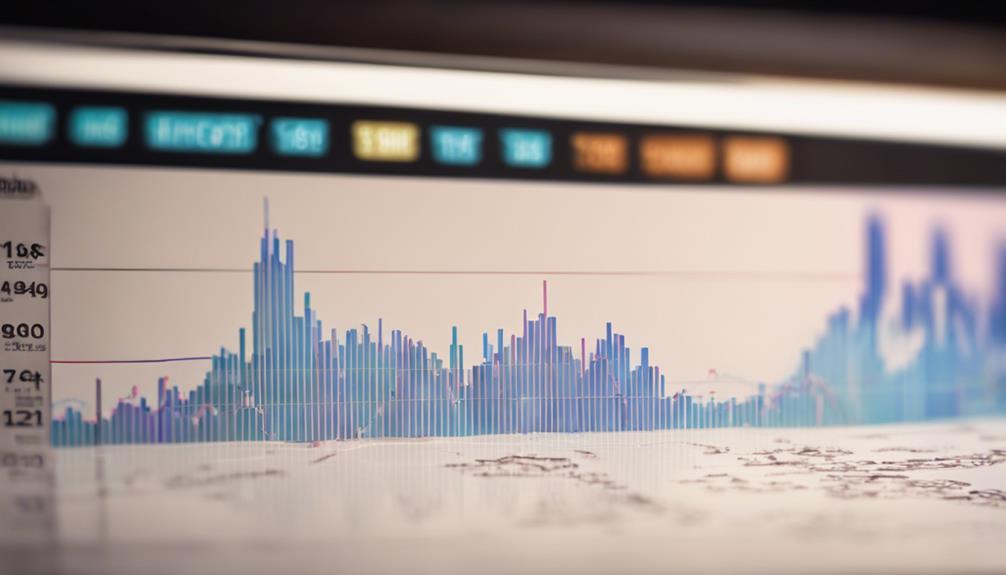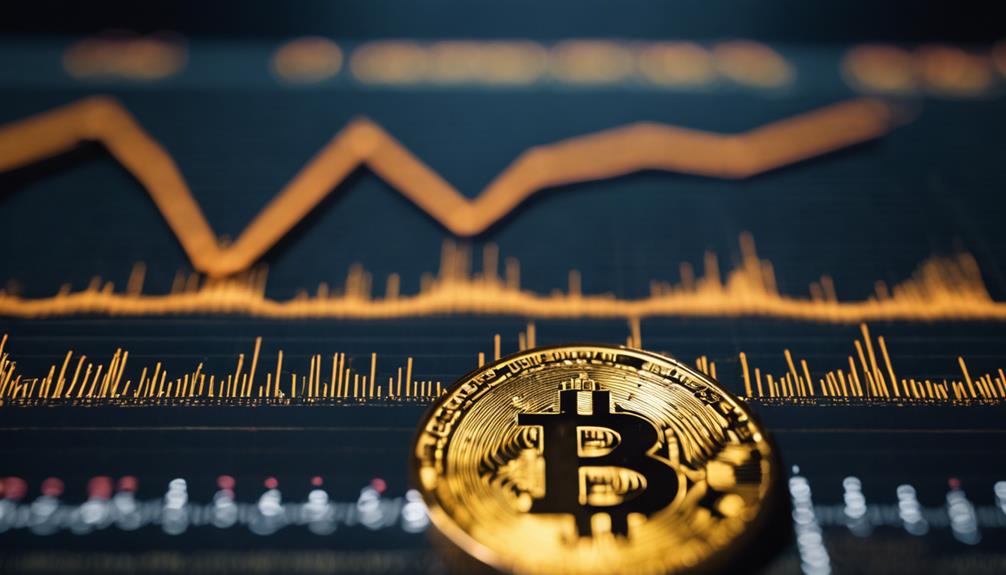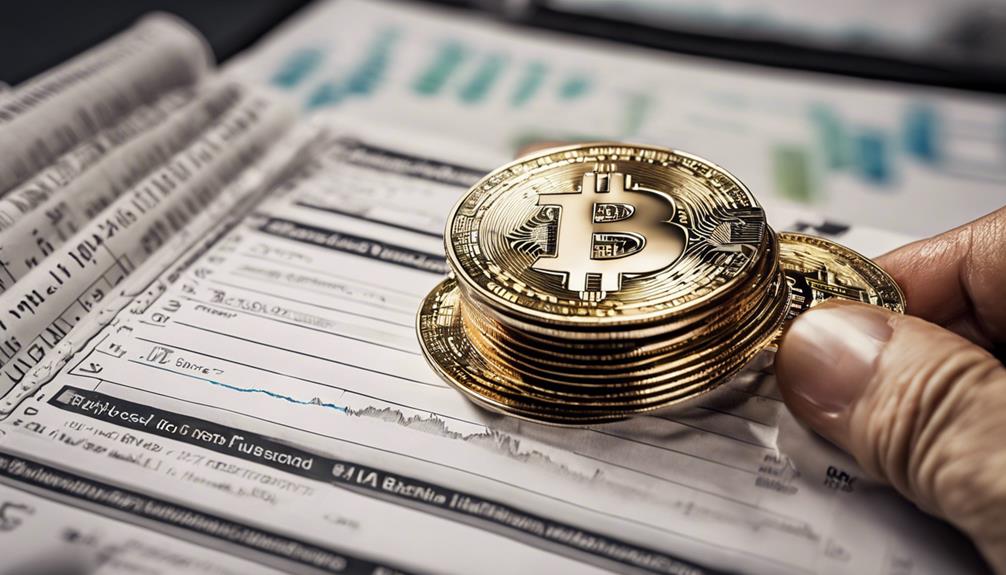Every four years, Bitcoin undergoes an important event known as the halving. During this period, the rewards miners receive for processing transactions are reduced by 50%. This process affects the overall supply of Bitcoin and changes the balance between supply and demand in the market. The halving events play a crucial role in maintaining Bitcoin’s scarcity and enforcing a maximum cap of 21 million coins. Furthermore, historical data shows that these events have had a substantial impact on the cryptocurrency’s price movements. Understanding these halving events is crucial to fully comprehend Bitcoin’s ecosystem and its future direction.
Key Takeaways
- Bitcoin undergoes a halving event every four years.
- The halving reduces mining rewards by 50%.
- It aims to maintain Bitcoin's scarcity.
- Halvings impact miners' profitability significantly.
- The total supply of Bitcoin is capped at 21 million coins.
Bitcoin Halving Overview

Exploring Bitcoin halving reveals a significant event that occurs every four years, impacting the cryptocurrency's supply and demand dynamics. Bitcoin halving refers to the process where the block reward for miners is cut in half, reducing the rate at which new bitcoins are created. This mechanism is built into the Bitcoin protocol to manage its total supply, ultimately capping it at 21 million coins. With halvings occurring approximately every 210,000 blocks in the blockchain, traders keenly monitor these events as they can influence the market's equilibrium between supply and demand.
The halving process plays an important role in Bitcoin's ecosystem by ensuring scarcity and preventing inflation. Miners, who secure the network by solving complex mathematical puzzles, receive a reduced reward after each halving, affecting their profitability. This adjustment in mining rewards not only impacts miners but also has wider implications for traders and investors, as it can influence the price of Bitcoin in the market.
Mechanism of Bitcoin Halving

Bitcoin halving is an integral part of the cryptocurrency ecosystem, affecting the rewards miners receive for validating transactions. As the reward is cut in half every four years, this reduction has a direct impact on the supply and demand dynamics of Bitcoin, potentially influencing its price.
Understanding the mechanism of Bitcoin halving sheds light on how this process contributes to the scarcity and value proposition of the leading cryptocurrency.
Halving Bitcoin Rewards
Every four years, the mechanism of Bitcoin halving automatically reduces mining rewards by 50%. This event, programmed into the Bitcoin protocol, cuts the reward for miners in half roughly every 210,000 blocks to maintain the digital asset's scarcity.
The next halving, expected in April 2024, will decrease the reward from 6.25 to 3.125 BTC. By managing block rewards, Bitcoin halving plays an important role in controlling the total supply and inflation rate of the cryptocurrency.
This process also influences the shift towards transaction fees becoming a more significant part of miner compensation. Understanding the impact of halving on mining rewards is essential for grasping the intricate dynamics that govern Bitcoin's ecosystem.
Impact on Price
Reducing mining rewards by 50% every four years through Bitcoin halving directly impacts the supply of new bitcoins. This reduction in rewards, encoded into the Bitcoin protocol, aims to establish a capped total supply of 21 million bitcoins, creating scarcity.
With fewer bitcoins entering circulation after each halving event, the supply decreases, potentially driving up demand. The interplay of reduced supply and steady demand post-halving has historically led to price increases in Bitcoin. This price impact is closely monitored by participants in the cryptocurrency market, including traders and investors, who analyze historical trends and market reactions to each halving cycle.
Understanding the mechanism of halving is essential for comprehending how it influences Bitcoin's price dynamics.
Impact on Bitcoin Miners

When Bitcoin miners' rewards are halved every four years, it intensifies the competition among miners aiming to earn the reduced rewards.
This reduction in rewards challenges miners to enhance their efficiency and lower operational costs to remain profitable.
As rewards decrease and competition rises, miners must adapt their strategies to navigate the changing landscape of the Bitcoin mining ecosystem.
Miner Rewards Halve
As Bitcoin miner rewards halve, the impact on Bitcoin miners' profitability becomes significant. This reduction in rewards directly affects the bottom line of miners, prompting them to adapt their strategies to maintain profitability and sustainability in the ever-changing landscape of Bitcoin mining.
Here are some key points to keep in mind:
- Halving events lead to a decreased amount of bitcoins rewarded to miners per block.
- Miners must optimize their operations and energy consumption to counterbalance the reduced rewards.
- The halving mechanism plays an essential role in managing Bitcoin's total supply and ensuring scarcity within the system.
- Balancing profitability while managing supply becomes a delicate dance for miners in the face of halving events.
Increased Mining Competition
Facing increased mining competition post-halving, Bitcoin miners must continually adapt to optimize efficiency and profitability in a challenging environment. The reduced rewards from halving events intensify competition, impacting the profitability of miners.
This heightened competition drives the need for miners to optimize their operations and focus on energy efficiency to remain competitive. As a result of halving events, there's often consolidation among miners, favoring larger mining operations that can better withstand the pressures of reduced rewards.
Conversely, smaller miners may face difficulties post-halving due to the combination of lower rewards and increased competition in the mining space. Adapting to these changes is vital for miners to navigate the evolving landscape of Bitcoin mining effectively.
Bitcoin Halving Schedule

The periodic Bitcoin halving events punctuate the currency's supply schedule with significant reductions in mining rewards. This process plays an important role in shaping Bitcoin's scarcity and deflationary nature, ultimately impacting its total supply of 21 million coins. The next halving is anticipated around April 2024, where the mining reward will decrease from 6.25 to 3.125 bitcoins per block.
Here are some key points to take into account about the Bitcoin halving schedule:
- Halving events occur every four years, reducing mining rewards by 50%.
- The schedule is linked to the creation of new blocks, typically happening after approximately 210,000 blocks.
- Each halving contributes to the limited supply of Bitcoin, enhancing its scarcity over time.
- By 2140, the halving mechanism aims to cap the total number of Bitcoins at 21 million coins, ensuring a controlled and predictable issuance process.
Historical Bitcoin Halving Events

Exploring the timeline of Bitcoin halving events reveals significant reductions in mining rewards every four years. The first halving, on November 28, 2012, saw the mining reward drop from 50 to 25 BTC per block.
Subsequently, on July 9, 2016, the second halving occurred, further reducing the reward to 12.5 BTC per block. The third halving, on May 11, 2020, marked another decrease to 6.25 BTC per block.
Looking ahead, the next halving is anticipated on April 17, 2024, where the reward will be halved once more to 3.125 BTC per block. These historical halving events play a significant role in managing the issuance of new bitcoins, ultimately aiming to reach the maximum supply of 21 million bitcoins around 2140.
Each halving event signifies a milestone in Bitcoin's network economics, impacting miners and the overall scarcity of the cryptocurrency. By understanding these past events, one can grasp the gradual progression towards the fixed supply limit and its implications for the future of Bitcoin.
Future of Bitcoin Supply

With Bitcoin's total supply gradually approaching its 21 million coin limit, the future of Bitcoin's supply dynamics hinges on the scheduled halving events every four years.
- The supply of new bitcoins is reduced by half during each halving event, making it harder for miners to earn rewards.
- The total supply of Bitcoin is fixed at 21 million coins, ensuring scarcity and driving its value proposition.
- The number of new coins created with each block decreases with every halving, leading to a gradual slowing down of Bitcoin issuance.
- The next halving, anticipated around 2028, will further decrease mining rewards, emphasizing Bitcoin's deflationary nature and reinforcing its status as a store of value asset.
Bitcoin's future supply dynamics are intricately linked to these halving events, shaping its scarcity, deflationary characteristics, and appeal as a long-term investment. As the number of new coins generated decreases over time, the concept of scarcity becomes more pronounced, potentially increasing Bitcoin's attractiveness as a store of value in the financial landscape.
Price Dynamics Post-Halving

After each Bitcoin halving event, we typically observe a historical rise in the digital asset's price. The reduction in the rate of new Bitcoin supply entering the market post-halving often leads to an increase in the price of the digital asset. Simultaneously, the heightened demand for Bitcoin following halving events contributes to driving its price upwards. While price volatility is common in the short term around halving events, historical trends show long-term price appreciation for Bitcoin. Investors keenly monitor the price dynamics post-halving for potential investment opportunities in this digital asset.
| Price Dynamics Post-Halving | |
|---|---|
| Supply Reduction | Increase in Price |
| Demand Increase | Long-term Appreciation |
| Price Volatility | Investment Opportunities |
| Post-Halving Effects | Historical Price Trends |
| Bitcoin Halving | Digital Asset |
Significance of Bitcoin Halving

The importance of Bitcoin halving lies in its pivotal role in controlling the issuance of new bitcoins, ensuring scarcity in the system, and historically driving price appreciation for the digital asset.
- Reduced Mining Rewards: Bitcoin halving reduces mining rewards by 50% every four years, impacting the rate at which new coins are introduced into the system.
- Scarcity Maintenance: By limiting the total supply to 21 million coins, halving events help in maintaining scarcity, making Bitcoin a sought-after asset.
- Increased Demand: The reduction in mining rewards post-halving can stimulate increased demand for Bitcoin as its availability becomes more limited.
- Price Appreciation: Historically, halving events have led to significant price appreciation for Bitcoin as the supply of new coins dwindles, showcasing its deflationary nature compared to inflationary fiat currencies.
Understanding the significance of Bitcoin halving is essential for investors and enthusiasts alike, as it underpins the unique economic model of this leading cryptocurrency.
Frequently Asked Questions
Why Does Bitcoin Go up Every 4 Years?
Bitcoin goes up every four years due to a unique event called a halving. This process reduces mining rewards by 50%, controlling Bitcoin's inflation and maintaining scarcity. With fewer new Bitcoins entering circulation, demand tends to increase, driving up the price.
Historical data supports this trend, showing price rises after each halving. The next halving, projected in 2024, will impact Bitcoin mining economics, further influencing its value.
Is Every Four Years Bitcoin Cut in Half?
Every four years, Bitcoin undergoes a halving event, where the mining reward is cut in half. This process is an essential aspect of Bitcoin's protocol and occurs approximately every 210,000 blocks.
It plays a vital role in controlling the issuance and scarcity of Bitcoin by gradually reducing the rate at which new Bitcoins are created. These halving events have a substantial impact on Bitcoin's economic model and market dynamics.
What Happens to Bitcoin in 2024?
In 2024, Bitcoin will experience its fourth halving event, reducing the mining reward to 3.125 BTC per block. This reduction aims to maintain the deflationary design of Bitcoin, limiting the total supply to 21 million coins.
Previous halving events have historically led to price increases, drawing attention from traders and investors. The 2024 halving, expected around April 17 at block number 840,000, is anticipated to impact market dynamics and price movements.
How Many Years Will Bitcoin Last?
We estimate Bitcoin will last until approximately 2140 due to its capped supply of 21 million coins.
The halving process, occurring roughly every four years or every 210,000 blocks, gradually reduces new bitcoin issuance.
This mechanism, akin to a slow-burning candle, helps Bitcoin maintain scarcity and control inflation.
Consequently, Bitcoin's finite supply, combined with halving events, enhances its potential as a long-term store of value.
How Does Bitcoin’s 4-Year Cycle Impact Its Safety Compared to Gold?
The Bitcoin versus gold safety debate revolves around the 4-year cycle impact. While gold has historically been a safe haven asset, Bitcoin’s fixed supply and halving events have led to increased safety perception among investors. The predictable scarcity of Bitcoin may offer a unique safety advantage over gold in the long run.
Conclusion
To sum up, every 4 years, Bitcoin undergoes a halving event which reduces the rewards for miners by half. This scarcity mechanism is built into the protocol to control the supply of Bitcoin and maintain its value.
An interesting statistic is that after the previous two halving events, Bitcoin's price experienced significant increases, showcasing the impact of this unique feature on the cryptocurrency's market dynamics.











